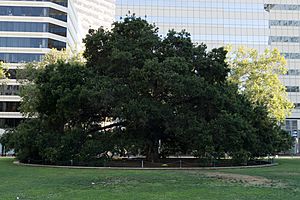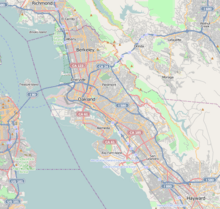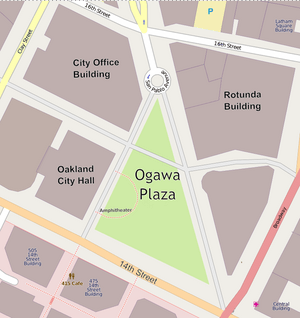Frank H. Ogawa Plaza facts for kids

Oak Tree growing in Frank H. Ogawa Plaza
|
|
| Former name(s) | City Hall Plaza |
|---|---|
| Namesake | Frank H. Ogawa |
| Area | 160,000 square feet (15,000 m2) |
| Coordinates | 37°48′18″N 122°16′18″W / 37.8050°N 122.2718°W |
| Construction | |
| Inauguration | 1998 |
Frank H. Ogawa Plaza is a busy public square in Downtown Oakland, California. It's a central spot for the city, located right in front of Oakland City Hall. People come here for events, protests, or just to relax.
Contents
What You'll Find at Frank H. Ogawa Plaza
Frank H. Ogawa Plaza is where several streets meet, like San Pablo Avenue and Broadway. The Oakland City Hall building is on one side of the plaza. Many old buildings around the plaza have a beautiful style called Beaux-Arts. Newer buildings have been built to match this classic look.
Size and Main Areas
The plaza is a large public space, about 160,000 square feet (14,864 square meters). Most of it is a raised grassy area called "The Commons." There's also "The Forum," which is like an outdoor stage or amphitheater. This is a great spot for public gatherings and performances. Part of San Pablo Avenue next to the plaza is now just for people walking, not cars. You can also find an entrance to the 12th Street/Oakland City Center BART train station here.
The Famous Oak Tree
Right in the middle of the plaza stands a large Coast Live Oak tree. This tree is very special because it's a symbol of the city of Oakland itself. It represents strength and growth for the community.
Nearby Places
The plaza is next to the Oakland City Center complex. This area has many shops and offices. Just one block away is Latham Square, another small plaza where two main streets, Telegraph Avenue and Broadway, come together.
History of the Plaza
This public space has a long history. Even back in 1896, the famous writer Jack London gave speeches here when it was called "City Hall park." The area in front of City Hall was part of a big project to improve downtown Oakland. The renovated plaza was officially finished in 1998.
Art and Events
Besides being a government center, the plaza is also a place for art and culture. The yearly Art and Soul Festival brings music and fun to the area. In 2001, the city asked artist Bruce Beasley to create a sculpture for the plaza. His artwork, called Vitality, was completed in 2002.
A Place for Voices
Frank H. Ogawa Plaza has often been a place where people gather to share their opinions. It's a common spot for protests and public discussions.
Why the Plaza Was Renamed
In 1998, the Oakland City Council decided to rename City Hall Plaza. They chose "Frank H. Ogawa Plaza" to honor Frank H. Ogawa. He was an important civil rights leader and the first Japanese American to serve on the Oakland City Council. Ogawa was on the Council from 1966 until he passed away in 1994. There is a bronze statue of him in the plaza.
Occupy Oakland Protests
In the fall of 2011, a group called Occupy Oakland used Ogawa Plaza as a main gathering spot for their protests. They stayed there for a while to bring attention to their ideas. Some people worried about health and safety during this time. However, others supported the group. The protesters even unofficially renamed the plaza "Oscar Grant Plaza." They did this to honor Oscar Grant, a young man whose death in 2009 led to many protests and calls for change in the community.




